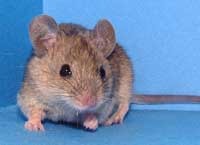Strain Data Sheet
RBRC00208
Strain Information | |
|---|---|
| Image |  |
| BRC No. | RBRC00208 |
| Type | Wild-derived strain, partially inbred |
| Species | Mus spretus |
| Strain name | M. spretus |
| Former Common name | M. spretus |
| H-2 Haplotype | |
| ES Cell line | |
| Background strain | SPR2 [Mus spretus] |
| Appearance | white-bellied agouti [Aw/Aw , B/B, C/C] |
| Strain development | Deposited by Rosemary Elliott, Roswell Park Cancer Institute. |
| Strain description | M. spretus, SPR2 inbred strain, derived from Mus spretus wild mice trapped in Spain and maintained by Roswell Park Cancer Institute as random stock. Mice were introduced to the RIKEN Tsukuba Institute in 1998 from Dr. Verene Chapman. Among them the inbred line has been created. This strain has been reported to be resistant to the development of skin cancer. M.spretus produces sterile F1 males with laboratory strains. |
| Colony maintenance | Sibling x Sibling. |
| References | Evidence for the presence of two sympatric species of mice (genus Mus L.) in southern France based on biochemical genetics. Britton J, Thaler L Biochem. Genet., 16(3-4):213-225 (1978). 678291 |
Health Report | |
|---|---|
| Examination Date / Room / Rack | 2024/11/25Room:4-CRack:ESentinel mouse program 2024/08/26Room:4-CRack:ESentinel mouse program 2024/05/27Room:4-CRack:ESentinel mouse program 2024/02/26Room:4-CRack:ESentinel mouse program 2023/11/27Room:4-CRack:ESentinel mouse program 2023/08/28Room:4-CRack:ESentinel mouse program 2023/05/29Room:4-CRack:ESentinel mouse program |
Gene | |||||||
|---|---|---|---|---|---|---|---|
| Gene Symbol | Gene Name | Chr. | Allele Symbol | Allele Name | Common Names | Promoter | Diseases Related to This Gene |
Phenotype | |
|---|---|
| Annotation by Mammalian phenotyhpe ontology | |
| Detailed phenotype data | |
Ordering Information | |
|---|---|
| Donor DNA | |
| Research application | Genetics Research Reproductive Biology Research |
| Specific Term and Conditions | No specific terms and conditions. (The DEPOSITOR waives its own rights under any patents, intellectual property, or other proprietary rights with respect to the results to be obtained by use of the BIOLOGICAL RESOURCE.) |
| Depositor | Roswell Park Cancer Inst. (Roswell Park Cancer Inst.) |
| Strain Status |  Live mice Live mice Frozen embryos Frozen embryos Frozen sperm Frozen sperm |
| Strain Availability | Cryopreserved sperm (within 1 month) Cryopreserved embryos (within 1 month) Live mouse (3 to 6 months) |
| Additional Info. | Necessary documents for ordering:
Click Here for Mouse genomic DNA (RIKEN DNA Bank) |
BRC mice in Publications |
|---|
Dudka D, Dawicki-McKenna JM, Sun X, Beeravolu K, Akera T, Lampson MA, Black BE. Satellite DNA shapes dictate pericentromere packaging in female meiosis. Nature (2025) 39779853 |
Aizawa S, Nishimura K, Mondejar GS, Kumar A, Bui PL, Tran YTH, Kuno A, Muratani M, Kobayashi S, Nabekura T, Shibuya A, Sugihara E, Sato TA, Fukuda A, Hayashi Y, Hisatake K. Early reactivation of clustered genes on the inactive X chromosome during somatic cell reprogramming. Stem Cell Reports 17(1) 53-67(2022) 34919813 |
Hasegawa A, Mochida K, Matoba S, Inoue K, Hama D, Kadota M, Hiraiwa N, Yoshiki A, Ogura A. Development of assisted reproductive technologies for Mus spretus†. Biol Reprod 104(1) 234-243(2021) 32990726 |
Kono H, Tamura M, Osada N, Suzuki H, Abe K, Moriwaki K, Ohta K, Shiroishi T. Prdm9 polymorphism unveils mouse evolutionary tracks. DNA Res 21(3) 315-26(2014) 24449848 |
Oka A, Mita A, Takada Y, Koseki H, Shiroishi T. Reproductive isolation in hybrid mice due to spermatogenesis defects at three meiotic stages. Genetics 186(1) 339-51(2010) 20610405 |
Kawakami M, Yamamura K. Cranial bone morphometric study among mouse strains. BMC Evol Biol 8 73(2008) 18307817 |
Johnsen JM, Levy GG, Westrick RJ, Tucker PK, Ginsburg D. The endothelial-specific regulatory mutation, Mvwf1, is a common mouse founder allele. Mamm Genome 19(1) 32-40(2008) 18188647 |
Kaneko S, Aki I, Tsuda K, Mekada K, Moriwaki K, Takahata N, Satta Y. Origin and evolution of processed pseudogenes that stabilize functional Makorin1 mRNAs in mice, primates and other mammals. Genetics 172(4) 2421-9(2006) 16415359 |
Hirotsune S, Yoshida N, Chen A, Garrett L, Sugiyama F, Takahashi S, Yagami K, Wynshaw-Boris A, Yoshiki A. An expressed pseudogene regulates the messenger-RNA stability of its homologous coding gene. Nature 423(6935) 91-6(2003) 12721631 |